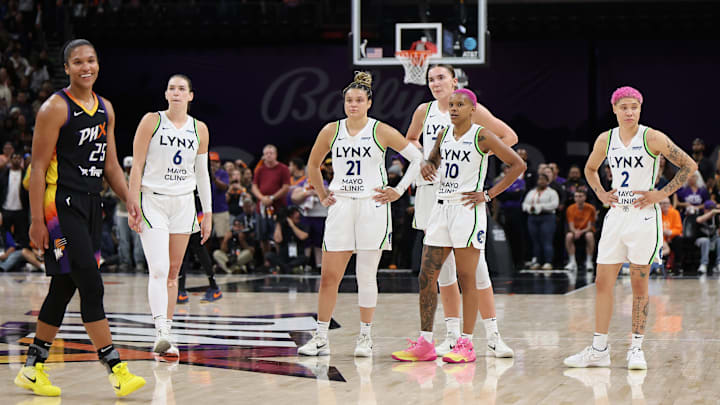After a postseason run that widely fell short of expectations, the Minnesota Lynx entered an offseason full of uncertainty and looming changes. The only two players under contract for the 2026 season are Dorka Juhasz, who sat out the 2025 season, and Anastasiia Kosu. Even if the Lynx re-sign core players like Napheesa Collier, Kayla McBride, Alanna Smith, and Courtney Williams, the roster needs some tweaks.
Minnesota dominated both ends of the floor in the regular season, leading the league in offensive and defensive rating. Nevertheless, the playoffs exposed some roster weaknesses. For one, the Lynx’s frontcourt lacked size compared to other teams’ big rotations. Landing Lauren Betts or Awa Fam in the draft could help address that issue. Moreover, the Lynx need more offensive production from the wing. The semifinals made the latter issue abundantly clear.
The Lynx lacked production and depth at the three
Between Napheesa Collier, Alanna Smith, Jessica Shepard, and Maria Kliundikova, the Lynx had a strong big rotation. They also got plenty of production at the two guard spots from Courtney Williams, Kayla McBride, and Natisha Hiedeman. Meanwhile, the small forward spot was a noticeable question mark.
The Lynx started Bridget Carleton at the three. At 6’2”, Carleton offers good size at the small forward spot. She is also a strong defender and can space the floor. However, Carleton wasn’t as productive offensively as she was in 2024, averaging three fewer points per game and shooting below 40% from three during the regular season. In the playoffs, she averaged 5 points on 31% shooting from the field and 36.8% from three.
The depth behind Carleton was thin as well. Early in the season, the Lynx had Karlie Samuelson, who could back up either McBride or Carleton, playing minutes at the shooting guard and small forward spots, and Diamond Miller, who saw some minutes at the three but never fully gained Cheryl Reeve’s trust.
When Samuelson went down with a season-ending injury, the Lynx’s perimeter depth got even thinner. They addressed the issue by trading Miller, Samuelson, and a 2027 second-round pick for DiJonai Carrington. Carrington gives up some size at the three, but can fill either the shooting guard or the small forward spot. She can also create offense, something the Lynx needed behind McBride and Carleton. However, Carrington also went down with an injury and missed most of the playoffs.
Her absence forced the Lynx to play Carleton heavy minutes, even when her shot wasn’t falling, and sometimes to resort to three-guard lineups of Williams, Hiedeman, and McBride that gave up a lot of size against the Phoenix Mercury. While that trio promises a lot of speed and offense, it isn’t ideal against a team that features Kahleah Copper and Satou Sabally at the two and three.
If the Lynx want to return to the finals, upgrading the wing depth or even getting more of a scoring threat to fill the starting small forward position will be crucial.
